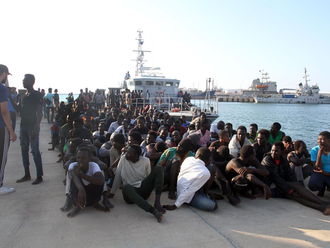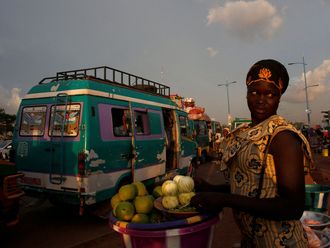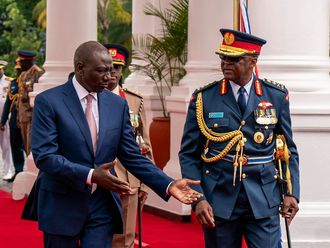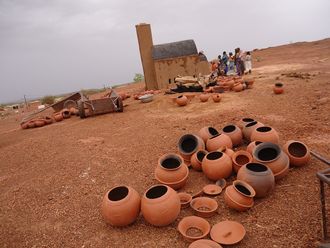MAIDUGURI, Nigeria: Slumped in his mother’s lap in a health clinic in northeast Nigeria, three-year-old Hassan was too drained to cry or protest as the nurse wrapped a tape measure tightly around his arm.
After weeks of fever, vomiting and diarrhoea — telltale signs of malnutrition — his gaunt face and glazed eyes were listless despite his mother’s efforts to coax him into eating from a packet of nutritious peanut-based paste.
“I’m scared we’ll end up coming back ... there is no food to eat here,” said Hassan’s mother, Kolo Adam, who fled with her six children to Maiduguri’s Bakassi camp for the displaced when Boko Haram militants attacked her village last year.
Some 450,000 children in three states that have been hardest hit by the Islamist group — Adamawa, Borno and Yobe — are expected to suffer from life-threatening malnutrition in 2017, according to the UN children’s agency Unicef.
At least 90,000 of these severely malnourished children could starve to death this year — an average of almost 250 a day — if they do not receive treatment urgently, Unicef said.
But aid workers fear the situation could be far worse with many areas cut off from help due to the threat of Boko Haram and aid hit by a lack of funding.
A military drive against the militant group has opened up remote parts of the region in recent months, revealing tens of thousands on the brink of starvation.
With farms empty or destroyed, trade and livelihoods ruined and the economy battered, food production and households’ purchasing power are plummeting.
“The extent of hunger and malnutrition in Borno state last year — and currently in the newly accessible areas — is at a level you rarely see anywhere,” said Arjan de Wagt, nutrition chief for Unicef Nigeria. “People don’t realise how bad it is.”
Breaking the cycle
While the government and aid agencies attempt to assess the scale of hunger and malnutrition in the region, health and relief workers in Borno are striving to provide food and treatment to millions of people affected by the conflict.
But the challenges they face are enormous.
In a health centre in Maiduguri, nurses chide the visiting mothers for feeding their children with dirty bottles, not breastfeeding properly, and failing to ensure they regularly eat the provided therapeutic food (RUTF) to stave off malnutrition.
“Some mothers are sharing the RUTF or selling it in order to feed their whole families,” said Abdulrazak Ibrahim, a doctor with Medecins Sans Frontieres (MSF), explaining how the RUTF must be eaten over six to eight weeks to treat malnutrition.
Many parents do not recognise the signs of malnutrition.
“The problem is that while a child may have stretched skin, patchy hair and sunken eyes, the parents see their swollen belly and think they are doing well,” said Anna, a nurse at Bakassi.
“Some mothers bring children in thinking they have malaria, while in fact they are on the brink of dying from malnutrition.” Just over a third of the 400,000 severely malnourished children in Adamawa, Borno and Yobe states received treatment last year, according to data from the UN. Office for the Coordination of Humanitarian Affairs (OCHA).
But ensuring that children who have been treated for malnutrition remain healthy is a constant struggle.
“We need to break the cycle of malnutrition,” said Amina Atta, a nutrition officer at Unicef. “But as the situation is so overwhelming right now, we are focusing on curative measures, rather than preventive ones, in order to stop children dying.”
Beyond comprehension
The number of people in northeast Nigeria without enough to eat is set to soar to 11 million this year — from 8.1 million — and more than 120,000 could suffer famine-like conditions, the UN. Food and Agriculture Organisation (FAO) said this month.
Coordinating aid has been a test for Nigeria, which is dealing with its first recession in 25 years as oil prices fall.
The government is investigating allegations of food aid being stolen and sold by state officials in Borno, and has said that aid agencies are exaggerating hunger levels to get more funding from international donors.
Yet the UN’s $484 million 2016 appeal for Nigeria has been just over half funded, and aid groups say the lack of cash means they are struggling to help people even in secure areas.
“The challenge is that there are areas in Borno ... that are still inaccessible, and we have no idea of the food security situation (there),” Ertharin Cousin, head of the UN. World Food Programme (WFP), told Reuters last month.
Several aid workers recalled visiting newly accessible/sareas studded with the graves of people who had died of hunger and seeing others eating goat skin in an effort to survive.
“It is beyond my comprehension,” said Iris Bollemeijer, a nutrition adviser at the International Medical Corps.
As the humanitarian emergency deepens, it is not only food which is in short supply — but hope.
At Bakassi camp, nurses could not hide their despair when Biba Gana arrived with her two-year-old granddaughter, Alima, who was suffering from malnutrition for a second time.
“We’re doing the best we can,” said nurse Anna, trying to soothe the crying baby. “But it’s so hard when we know that so many of these children will return here before too long.”












